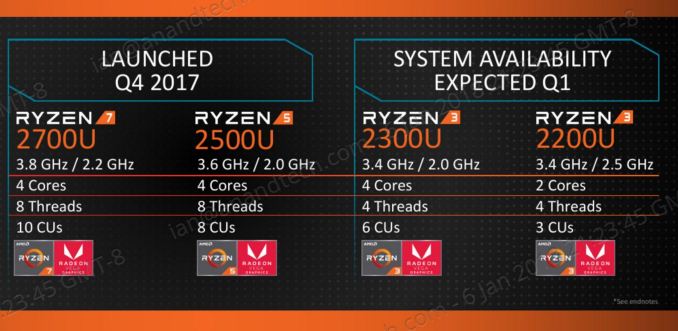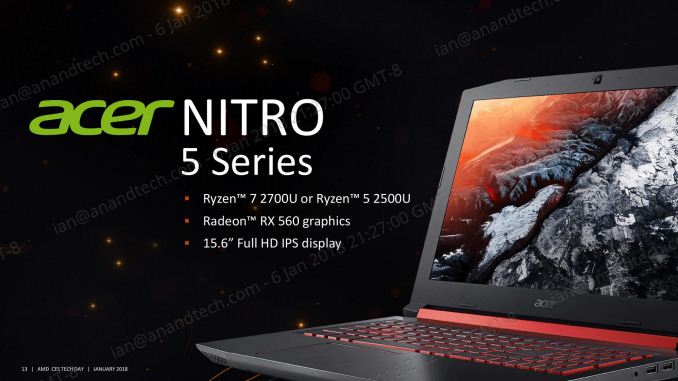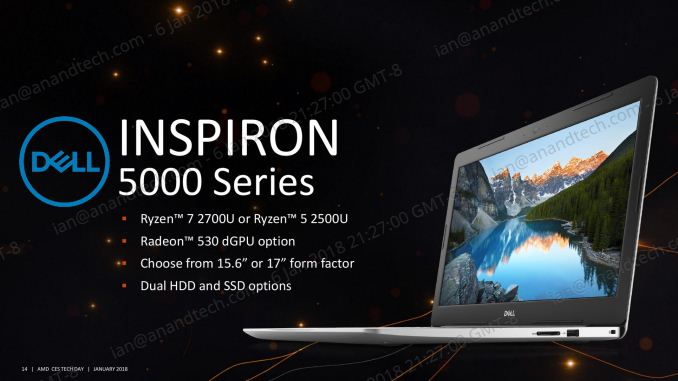AMD Tech Day at CES: 2018 Roadmap Revealed, with Ryzen APUs, Zen+ on 12nm, Vega on 7nm
by Ian Cutress on February 1, 2018 8:45 AM ESTZen Cores and Vega
Ryzen 3 Mobile, Plus More Ryzen Mobile Laptops
The most immediate announcement from AMD is two Ryzen 3 Mobile processors designed to fill out the Mobile stack, and the introduction of Ryzen-based APUs for desktop machines.
At the heart of both of these designs is the combination of AMD’s first-generation Zen cores, specifically four cores in a ‘core complex’, connected to Vega-based graphics integrated into the silicon. The two units are connected via AMD’s Infinity Fabric, designed for high-bandwidth and scale, and a feature that permeates through AMD’s recent product portfolio.
Ryzen Mobile
To date, AMD has already announced two products using this configuration. Both of them are for Ryzen Mobile, specifically the Ryzen 7 2700U and Ryzen 5 2500U, which have already been pre-announced in devices such as the HP Envy x2, the Lenovo Ideapad 720S, and the Acer Swift 3. Only the HP Envy x2 has been launched into the market so far (with mixed reviews due to the OEM design, which draws similar criticisms when equipped with Intel CPUs), with the others to see light in Q1 as well as other OEMs like Dell.
The first announcement is regarding adding more Ryzen Mobile processors to the family to cater for a wider audience. To pair with the Ryzen 7 Mobile and Ryzen 5 Mobile, AMD has two Ryzen 3 Mobile parts which will formally be available on January 9th with expected system availability within Q1.
| AMD Ryzen Mobile APUs | |||||
| Ryzen 7 2700U with Vega 10 |
Ryzen 5 2500U with Vega 8 |
Ryzen 3 2300U with Vega 6 |
Ryzen 3 2200U with Vega 3 |
FX-9800P (2015) |
|
| CPU | 4C / 8T 2.2 GHz Base 3.8 GHz Turbo Zen 14nm |
4C / 8T 2.0 GHz Base 3.8 GHz Turbo Zen 14nm |
4C / 4T 2.0 GHz Base 3.4 GHz Turbo Zen 14nm |
2C / 4T 2.5 GHz Base 3.4 GHz Turbo Zen 14nm |
Dual Module 2.7 GHz Base 3.6 GHz Turbo Excavator 28nm |
| GPU | Vega 10 10 CUs 640 SPs < 1300 MHz |
Vega 8 8 CUs 512 SPs < 1100 MHz |
Vega 6 6 CUs 384 SPs |
Vega 3 3 CUs 192 SPs |
GCN 1.2 8 CUs 512 SPs > 758 MHz |
| TDP | 15W | 15W | 15 W | 15 W | 15W |
| DRAM | Up to DDR4-2400 | DDR4-1866 | |||
| L2 Cache | 512 KB/core | 1 MB/module | |||
| L3 Cache | 1 MB/core | 4 MB/core | - | ||
| PCIe Lanes | ? | ? | ? | ? | 8 x PCIe 3.0 |
| Die Size | 209.78 mm2 | 250.4 mm2 | |||
| Transistors | 4.95 billion | 3.1 billion | |||
| Launch | October 2017 | January 2018 | May 2016 | ||
The Ryzen 3 2300U is a quad-core processor without simultaneous multithreading, which separates it from the other components. The base frequency of 2.0 GHz, a top turbo of 3.4 GHz, and a total of six compute units in the Vega graphics (this equates to 384 streaming processors). The Ryzen 3 2300U shares the same TDP as the other parts, coming in at 15W, and AMD wants to position this as a high-performance part for eSports capable notebooks, handily beating anything from Intel’s 7th Generation family.
The Ryzen 3 2200U is the only dual core component in AMD’s entire Ryzen product line, although it does have simultaneous multithreading to give it four threads in total. Having two fewer cores to fire up does give it a boost on the base frequency, coming in at 2.5 GHz, but the turbo frequency matches the other Ryzen 3 at 3.4 GHz. The 2200U is certainly the processor bringing up the rear, with only three compute units (192 streaming processors) in total, and helping AMD shift some of the processors that are not binned as aggressively as the higher-performance units.
AMD is promoting these two processors as capable elements of an entry level 15W notebook that can process DirectX 12, offer advanced video features, and be used in aesthetically pleasing designs with a long battery life, including 2-in-1s, ultrathin notebooks, and gaming laptops.
New Devices
Not to be content with just announcing a couple of new Ryzen Mobile processors, AMD was eager to promote new mobile devices that will be using Ryzen Mobile. To accompany the HP Envy x360, the Lenovo Ideapad 720S, and the Acer Swift 3, Q1 will see the launch of a new HP (under embargo until later this week), the Acer Nitro 5 series, and the Dell Inspiron 5000 series.
Acer’s Nitro line of laptops is typically aimed at the gaming crowd. The Nitro 5 dictates a 15.6-inch display, which in this case is a 1920x1080 IPS panel. Acer will use the pre-announced higher-end APUs, the Ryzen 7 2700U and Ryzen 5 2500U, but will also be pairing this with a Radeon RX 560 graphics chip. We were told by AMD that the integrated graphics and discrete graphics will be used in a switching context: for video playback, the lower power integrated graphics is used and the discrete is disabled, however the discrete graphics is fired up for gaming work. For compute, or for games that support multi-adaptor DirectX 12 technologies, both the integrated graphics and the discrete graphics should be available, however this is up to the game/software to implement.
The Dell Inspiron lines are more home/small-medium business-oriented devices, and here Dell is also using the Ryzen 7 2700U and Ryzen 5 2500U processors to offer peak Mobile APU performance. Designed more as a workhorse than for aesthetics, the Inspiron 5000 will offer AMD parts with 15.6-inch and 17-inch displays in a chassis that can support dual HDD/SSD options. The unit also comes with an optional Radeon 530 discrete GPU, which has 384 compute units based on AMD’s older GCN 1.0 architecture. This comes across as very odd, given that even the Ryzen 5 has 512 compute units of the newer Vega architecture. I can only assume that this provides extra displays for very specific customers, though for most it would seem an overly pointless addition.














131 Comments
View All Comments
Byte - Thursday, February 1, 2018 - link
The current references to upcoming zen are confusing as hell. There is Zen+ 2nd Generation and then Zen 2 coming out. Should leave out "2nd Gen" alltogether.neblogai - Thursday, February 1, 2018 - link
To fix mistakes in some tables:table on page 2: L3 cache should probably say simply '4MB' for all RR parts.
first table on page 3- two G-series OPNs have C4 (15W) written in their codes. They should be YD2200C5M4MFB + YD2200C5FBBOX and YD2400C5FBBOX + YD2400C5M4MFB, http://products.amd.com/en-us/compare?prod1=148&am...
And I still hope 209.78 mm2 die size for 2200U is wrong- and it is Banded Kestrel die. Or at least that BK will be coming to work as 2200U later.
Dragonstongue - Thursday, February 1, 2018 - link
I do not see a 39dba being anywhere close to "silent" this is above many others truth be told, if they went with a larger fan probably could have dropped Dba levels down, or if they use fancier blades to reduce air noise, something along that line.But yes, wraith max being priced at $60 is/was insane, I would say would be "fair" to be no more than $40. seeing as so many others are available in this price range that are at least as good if not superior, yes RGB adds some to price, but, the dimensions of the cooler and lack of thermal mass also means it will not cool as well or require a much louder fan/pressure to be "equivalent"
Shame no Vega or RX on 12nm (14nm+) pretty much no where that I can see (Canada) has any RX anything, they have Vega sure, but WAY above MSRP/MSEP, greed of sellers, greed of the makers drives price up and up, just means those who want a "gaming card" end up paying through the nose for it.
Nice to see AMD focus some attention on the ram overclock side of the equation, so one can use baseline higher memory speed or overclock or both to get that much more performance.
All in all, IMO AMD have really pushed forward to being far behind the pack (just barely staying alive) to in many ways being substantially better value and performance for $ spent (cpu/motherboard wise) and at least being competitive gpu wise (no they are not always, but have always been since Radeon 1900 days, sometimes more power more performance, sometimes power limited so not as much performance, cannot win every race, but, being able to "show up" is still very important, unlike say Matrox or Via who CANNOT even race the same race these days)
Sure wish their stock price was showing faith from investors/brokers, from bleeding money to pulling themselves out of the grave in less than 2 years against anything but easy competition says a lot, or at least it should be ^.^
mode_13h - Thursday, February 1, 2018 - link
GCN (Graphics Core Next) is one of the dumber architecture names out there. I sure hope it doesn't get succeeded by something we end up having to call "Next-Gen".WatcherCK - Thursday, February 1, 2018 - link
I wish AMD would release an uber APU (hmm just like Intel are doing) with a base performance of say solid 60 fps at 1440p for around 95W or less? I could get this APU and a board ram and a drive for a little more than what a discrete GPU is going for and in theory miners wont want them so they should be in stock for those that want to game...mode_13h - Thursday, February 1, 2018 - link
An APU that powerful would probably attract miners.Also, memory bandwidth is going to be a problem. To achieve that level of performance, the consoles had to use GDDR5. Intel had the right idea of giving the AMD GPU its own stack of HBM2.
phillock - Saturday, February 3, 2018 - link
Thanks to amd, intel drops its prices :)nikon133 - Sunday, February 11, 2018 - link
These new Ryzen APUs could make nice base for next-gen consoles... with some modifications... but then, console APUs are already custom solutions, so that should not be impossible.8 proper Ryzen cores running at over 3GHz and matching up-to-date GPU with sufficient number of CUs... would make quite powerful console at its core. Balanced one, too... it is hardly a secret that current consoles are under-powered on CPU side. Maybe Jaguar cores were necessity for this gen to keep price down, but next gen should be equipped at least with 8x Ryzen 3 cores?
mode_13h - Monday, February 12, 2018 - link
I think jaguar cores are much smaller than Ryzen cores. So, you'd probably be looking at 4 core/8 thread Ryzen APU - not 8 cores.Anyway, these APUs have much weaker iGPUs and much less memory bandwidth than current-gen consoles (excluding Nintendo).
mode_13h - Monday, February 12, 2018 - link
BTW, I'm sure XBox One X kept Jaguar simply because Ryzen wasn't yet ready. There's a very long lead time for this silicon.Also, it seems Jaguar's 28 mm cores are only 3.1 mm^2 per core, whereas Ryzen's 14 nm cores are 44 mm^2 (which sounds like it also includes cache). So, it seems pretty unrealistic to expect consoles will just drop in 8 Ryzen cores where they previously had 8 Jaguars.